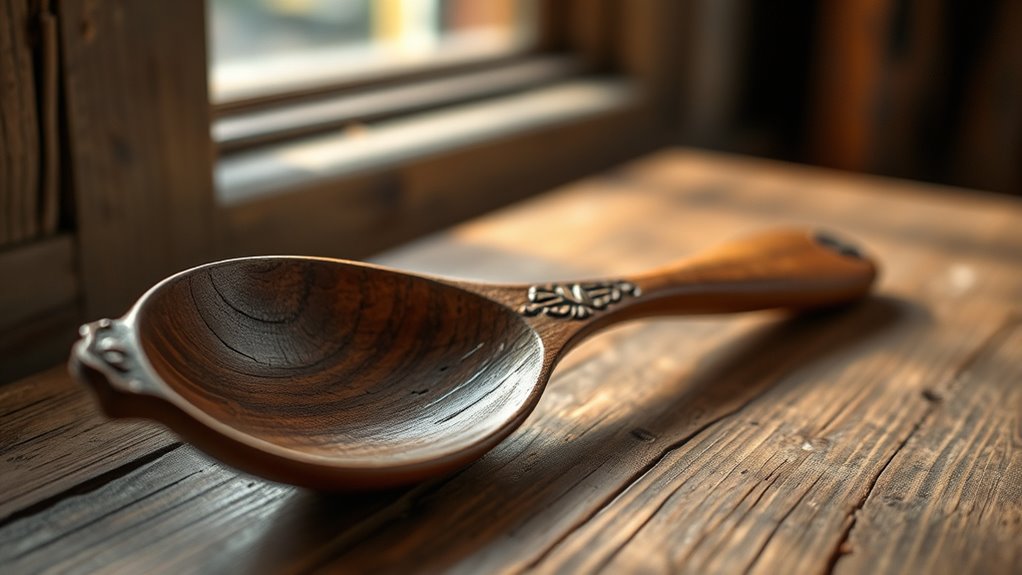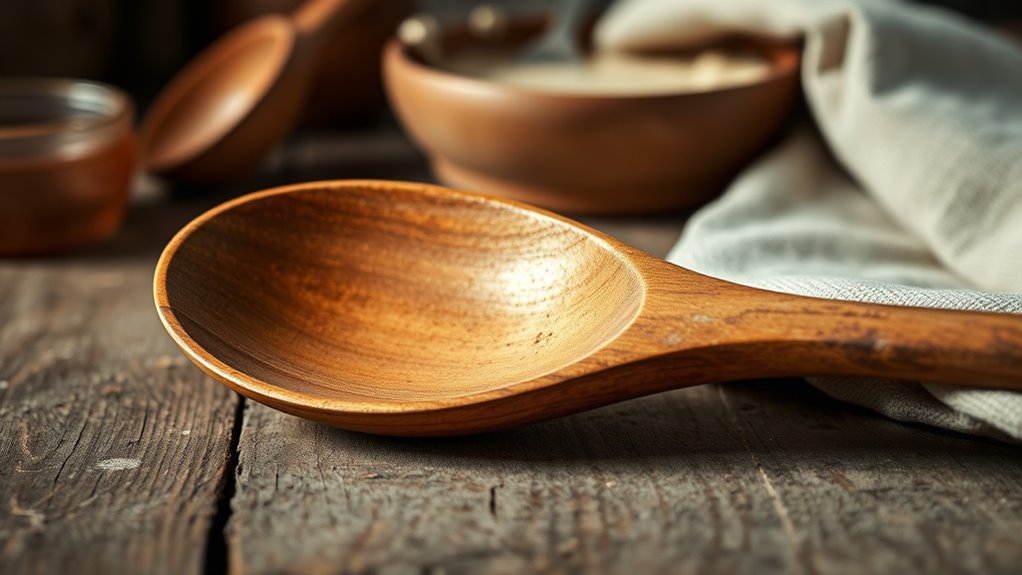Did you know wooden spoons date back to around 1000 BC in Ancient Egypt, where they held cultural and ceremonial importance? Early artisans carved these utensils with intricate patterns using techniques like kolrosing, turning them into symbols of artistry and social identity. Over time, cultures from the Celts to Vikings refined their designs, blending functionality and decoration. If you curiosity continues, you’ll discover how these simple tools became rich symbols of craftsmanship and tradition across history.
Key Takeaways
- Wooden spoons date back to around 1000 BC in Ancient Egypt, serving both practical and ceremonial purposes.
- Decorated spoons with intricate carvings often held symbolic or ceremonial significance in ancient cultures.
- Vikings and Roman societies crafted decorated wooden spoons, showcasing regional styles and craftsmanship.
- Techniques like kolrosing and carving with charcoal or coal dust added decorative and symbolic details.
- Today, wooden spoons are valued both as functional kitchen tools and as artistic, culturally significant crafts.

Have you ever wondered how a simple wooden spoon has such a rich history? These everyday tools date back to around 1000 BC in Ancient Egypt, where archaeological finds reveal their early use. Back then, they were crafted from materials like wood, bone, and metal, each chosen for their availability and durability. Wooden spoons weren’t just utilitarian; they carried cultural significance across different societies. Decorated examples from ancient civilizations show that these spoons often held symbolic or ceremonial value, with techniques like kolrosing used to carve intricate patterns into the wood. You can imagine how these decorated spoons might’ve been treasured possessions, reflecting artistry and social identity.
Ancient wooden spoons held cultural and ceremonial significance, featuring intricate carvings that reflected artistry and social identity.
As you trace their development through history, you’ll see influences from various European cultures. The Celts of the Iron Age used wooden spoons, and archaeological excavations in London have uncovered Roman spoons, indicating their widespread use. The Anglo-Saxons, known for their skilled woodworking, produced practical yet beautifully crafted spoons for everyday use. Vikings, famous for their decorative carvings, often used kolrosing techniques to adorn their spoons, turning a simple utensil into a work of art.
Throughout medieval Europe, wooden spoons remained common because they were affordable, easy to make, and suited for daily life. Their durability and practicality kept them relevant for centuries, making them a staple across many cultures.
The craftsmanship behind these spoons evolved over time. Artisans carved them with precision, often adding decorative elements like charcoal or coal dust to emphasize patterns. Different regions developed their unique styles, turning functional spoons into regional symbols of identity and artistry. Handcrafted wooden spoons were highly valued not just for their beauty but also for their durability, often passed down through generations. In addition to their decorative value, these spoons served important ceremonial and symbolic roles in many societies.
These spoons weren’t merely tools; they held cultural or symbolic meanings, helping societies express their traditions and beliefs.
You’ll also notice how versatile wooden spoons have been in practical applications. Used for stirring, serving, and preparing food, they offered economic advantages because they could be produced easily and in large quantities. Their non-reactive nature made them suitable for a wide range of culinary tasks, and when well-maintained, they could last for years, making them an enduring kitchen staple.
Across different cultures, wooden spoons have played a crucial role in food preparation and eating, bridging social and cultural divides.
Today, artisans continue to craft decorative wooden spoons, blending tradition with modern artistry. They symbolize more than just utility—they represent cultural history and craftsmanship. From simple beginnings to intricate designs, the wooden spoon’s evolution reflects a story of innovation, artistry, and cultural exchange that continues to this day.
Conclusion
Now, as you savor your wooden spoon, remember it’s more than just a kitchen tool—it’s a quiet keeper of history. Its simple presence hints at centuries of shared meals and subtle traditions. Each scratch and mark tells a story, reminding you that even the humblest objects can carry a world of meaning. So, cherish your wooden spoon; it’s a gentle reminder of the enduring charm found in everyday moments.









